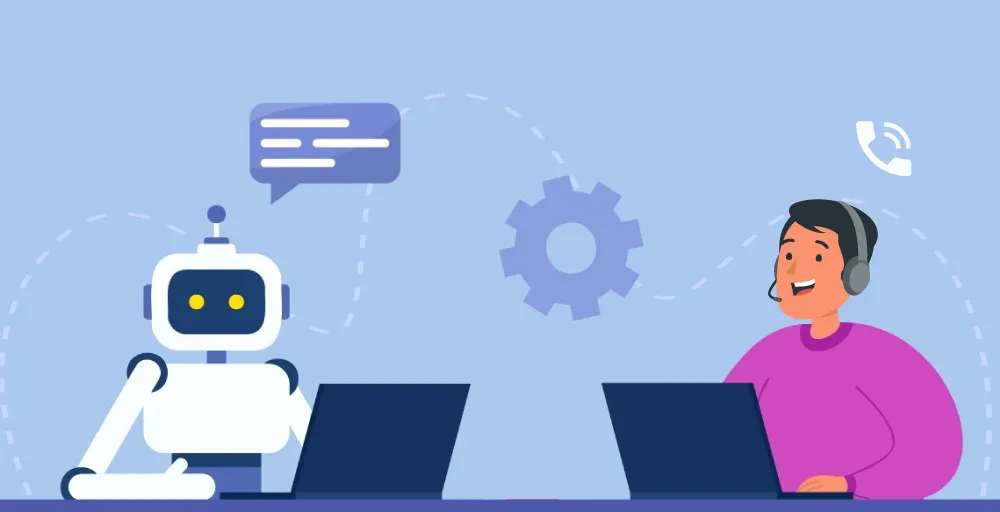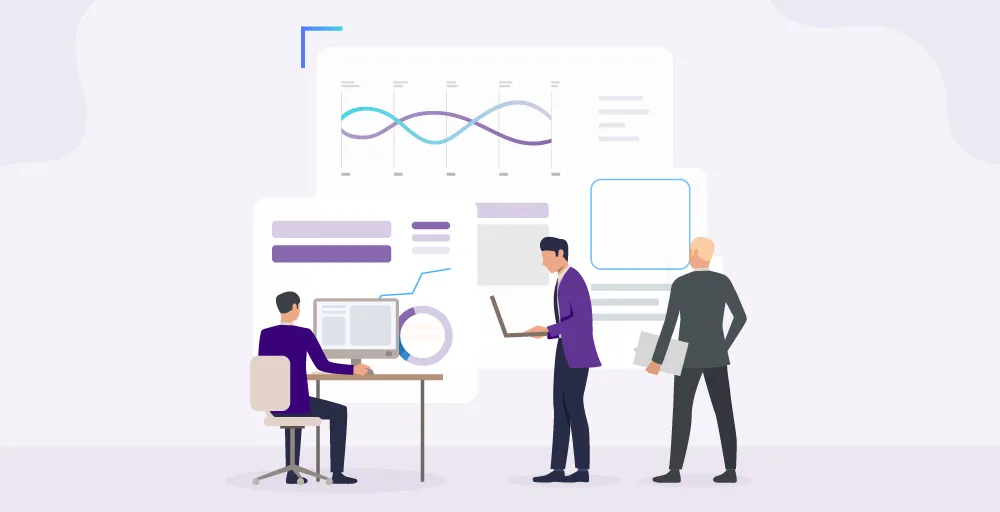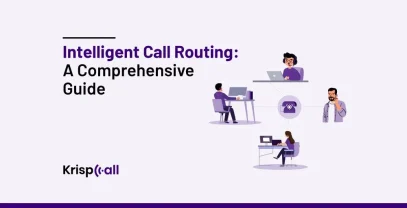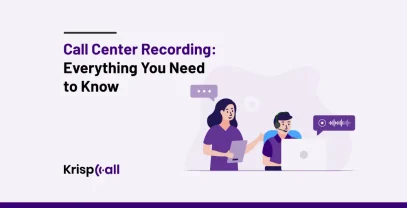Have you ever dialed☎️ a customer service line and been greeted by a friendly, helpful voice… only to realize it was a machine?
You are not alone. Many of us have experienced it, as call centers are integrating virtual agents🤖 and chatbots that use natural language processing (NLP) to handle customer issues.
In this article, we’ll discover how artificial intelligence is transforming call centers and improving the overall team efficiency of the call center.
🔑KEY HIGHLIGHTS
- Artificial Intelligence enhances operational efficiency and improves the overall customer service experience of the call center.
- AI is transforming call centers by automating tasks, routing the calls, analyzing real-time speech, managing the workforce efficiently, detecting frauds, and providing advanced analytics to make strong decisions.
- Implementing AI in a call center involves setting clear goals, embracing a human-AI partnership, prioritizing data quality and security, fostering continuous learning, and regularly monitoring and adapting strategies for optimal results.
- Introducing AI in your call center is a strategic upgrade with benefits like reduced agent costs, 24/7 availability, sentiment analysis, and automated tasks for improved efficiency.
- KrispCall optimizes call center operations, empowers agents, and enhances customer experiences through features like call analytics, monitoring, IVR, auto-dialer, and call routing for improved efficiency and goal achievement.
Let’s get started ⬇️
What is an Artificial Intelligence Call Center?
An Artificial Intelligence Call Center, also known as an AI-powered Contact Center, is a traditional call center infused with Artificial Intelligence technology.

AI is used in these kinds of call centers📞 to do things like analyze customer data, automate replies, increase efficiency, and boost productivity.
How is artificial intelligence transforming call centers?
Before Contact center AI, call centers were often frustrating and confusing. Customers hoped to connect with a human agent but they often faced a long wait time and got robotic interactions.
Agents were also burdened with customer inquiries, and repetitive tasks and lacked tools for personalizing the customer experience.
But now Artificial Intelligence AI is transforming the communication style of contact centers in various ways. Some of them are:
1. Manual to Automated Customer Interactions
Before AI, contact centers heavily relied on human agents for client interactions, resulting in longer response times😩 and increased errors.
Today, Instead of a real person, chatbots and virtual agents are handling the queries of customers and AI-powered analytics are providing agents with real-time insights for efficient issue resolution.
This resulted in a faster, more personalized, and more satisfying😃 experience for both customers and agents.
For Example, A customer calls about a delayed order. Instead of waiting on hold, they use a chatbot to track the package, confirm the new delivery date, and even reschedule if needed. This automated interaction resolves the issue quickly and frees up agents for more complex inquiries.
2. Reactive to Proactive Problem-Solving
Previously, the contact center waited for customers to have problems and then fixed✅ them. Now, with the help of contact center software, call centers can predict issues before they happen by analyzing data and identifying patterns. This allows businesses to proactively reach out to customers and offer solutions or support.
For Example, An AI system might identify a customer who is likely to experience service disruptions due to an upcoming weather event and automatically send them a notification with alternative options or support resources.
3. Manual to Optimized Call Routing
Manual call routing relied on agent🎧 availability or basic customer input which potentially led to misdirected calls and longer wait time. Now, call center AI uses smart algorithms to direct or route calls based on customer information reducing wait time and making sure resources are utilized well.
For Example, A customer calling about a technical issue is no longer directed through a generic process. Instead, the AI-powered system analyzes keywords like “internet outage” using natural language processing and instantly routes them to a specialized tech agent, minimizing hold times and providing quicker resolution.

4. Speech Analysis Challenges to Real-time Speech Analysis
Before AI, analyzing customer conversations in real-time was challenging. Now, with the evolution of AI-driven speech recognition technology, analyzing and providing valuable insights into how customers feel and how agents are doing has become easy. This has improved keeping an eye👀 on customer engagements.
For Example, A customer service agent receives a call with muffled audio. Real-time speech analysis instantly cleans up the background noise, ensuring clear understanding and resolving the issue smoothly despite the poor connection.
5. Limited to Enhanced Personalization
Personalizing customer interactions was limited before AI due to constrained access to real-time data. Nowadays, AI-enabled system uses up-to-the-minute customer information🧾 to customize interactions resulting in improved solutions and suggestions that contribute to increased customer happiness and loyalty.
For Example, A basic chatbot greets customers by name, but AI now analyzes purchase history and preferences to recommend relevant products in real time, taking personalization from generic greetings to tailored suggestions.
6. Enhanced Workforce Management Efficiency
Before AI, Managing the call center workforce was challenging with manual tasks, limited data, high turnover, and inflexible❌ schedules. AI has now simplified the process of automating jobs, providing real-time information, predicting trends, and improving call center training.
Example: A call center with global operations previously struggled to align agent schedules with customer demand across time zones. Call center AI now analyzes historical data and real-time call patterns to create dynamic schedules that match agent availability to peak call times in different regions, ensuring efficient coverage and shorter wait times for customers worldwide.

7. Fraud Detection and Prevention
Traditionally, call center fraud detection relies on human intuition and post-incident analysis leaving businesses vulnerable. The integration of AI has enabled real-time analysis swiftly identifying suspicious patterns and reducing delays. It continuously monitors✍️ to enhance the efficiency of the call centers against emerging threats.
For Example, A caller claims a forgotten account with a shaky voice. AI detects biometrics mismatch, quietly alerting agents to verify identity before potential fraud unfolds.
8. Data-Driven Decision-Making
Before AI, Call centers used to make decisions without strong data insights. Nowadays, with Call center AI, call centers make informed decisions based on advanced analytics. It includes better forecasting, optimized resource allocation, and overall improved decision-making processes.
For Example, A call center analyzes data showing customers often abandon calls after waiting on hold for more than 3 minutes. They use this insight to hire additional agents during peak hours, reducing wait times and boosting customer satisfaction.
What are the best practices for implementing AI in a Call Center?
Implementing AI in a call center can be very beneficial, but it’s crucial to do it right. Here are some best practices for implementing AI in a Call Center:
- Define your goals and align them with AI’s strengths: Don’t chase technology trends. Identify your pain points (long wait times, agent burnout, etc.) and choose AI solutions that directly address them.
- Embrace the human-AI partnership: Don’t replace agents with AI as AI doesn’t replace agents. Instead, train agents to use AI tools, analyze🔎 customer behavior and insights, and handle complex situations where a human touch is essential.
- Prioritize data quality and security: AI works most effectively when given clean and precise data. Ensure your systems are integrated and data is readily available. Prioritize data security and be transparent with customers about how their information is used.
- Foster a culture of continuous learning: AI is constantly evolving. Invest in ongoing training for both agents and leadership to ensure everyone stays up-to-date with the latest advancements and best practices.
- Measure, analyze, and adapt: Continuously monitor your AI implementation. Monitor essential metrics📈, assess their influence on goals🎯, and be ready to adjust your strategy based on the insights gained.
What are the Benefits of Using AI in Call Center?
Introducing AI to your call center isn’t just a tech upgrade – it’s a strategic move. Here’s how call centers can get benefits from using AI:

- Reduced Agent Costs: By automating routine tasks, AI allows human agents to focus🔍 on more complex interactions, improving agent efficiency and lowering labor expenses.
- 24/7 Availability: Unlike human agents, AI-powered systems don’t require breaks or sleep and can provide continuous support 24/7🕛. This constant availability ensures that customers can access assistance and information whenever they need it, regardless of time zones or business hours.
- Sentiment Analysis: Using advanced algorithms, AI systems can analyze real-time customer engagements, evaluating customer sentiment and emotional signals. This allows call centers to swiftly identify and address customer satisfaction or dissatisfaction.
- Automated Tasks: By utilizing artificial intelligence, routine📋 and repetitive tasks such as data entry, information retrieval, and basic query resolution can be efficiently automated. This not only reduces the burden on human agents but also enhances contact center operations by ensuring swift and accurate task execution.
Predictions & Future Trends: AI Call Center Software
People see AI as a technology that can make call centers work better. AI can understand speech📢, learn from it, and talk to customers effectively, making it useful for both the customer and agents.
As it continues to evolve, AI will understand emotions🤗 and context, tailoring interactions for a more natural experience. Advanced virtual assistants will understand complex questions and requests, making interactions smoother.
Biometric voice🔉 recognition and sentiment analysis will further personalize interactions and identify high-risk or urgent calls for immediate agent attention.
As AI technology continues to advance, AI tools🛠️ will become valuable for agent training and development, offering personalized feedback and coaching in real life.
How does KrispCall empower agents and customers?
KrispCall is more than just a call center solution, it helps to optimize call center operations, foster an environment that empowers agents, and enhance customer experiences. Here’s how KrispCall empowers call center agents and customers:
- Call Analytics: Using call analytics data, call center agents and managers can get valuable customer data to assess performance and identify areas for improvement.
- Call Monitoring: Enabling call monitoring can help to assess the team’s performance providing valuable insights for coaching and improvement.
- Interactive Voice Response(IVR) and Dial Groups: Agents can improve call efficiency by using Interactive Voice Response to direct callers to the right department or agents reducing the wait times of customers.
- Auto Dialer: This feature helps to increase agent performance and efficiency by automatically dialing numbers, saving time, and optimizing outbound calling.
- Call Routing: Agents can use the call routing feature to direct the calls to the most suitable agent or department & increase agent efficiency and reach call center goals.
Final Words
Call center software like KrispCall transforms call centers by addressing common challenges💪, making operations smoother, customers happier, and agents more capable.
As AI technology evolves, we can expect🤔 more innovations that will redefine the customer experience by understanding emotions and content for more natural interactions.
So, the next time you call a customer service line, don’t be surprised if you’re greeted by a friendly AI assistant. Embrace the future of call centers, where technology and human expertise work together🤝 to create a seamless, efficient, and ultimately more positive experience for everyone involved.
FAQ
1. Are there any potential drawbacks or risks associated with using AI in Call Center?
Yes, there are a few potential drawbacks that are associated with using AI Call Center. They lack human touch, technical glitches, data privacy concerns, algorithmic bias, potential job displacement, and initial costs.
2. How is AI impacting the role of human call center agents?
AI is impacting the role of human call center agents by handling their daily tasks, freeing them from complex issues, and empowering them with knowledge and insights, making them more efficient and customer-focused.
3. Can AI handle complex customer inquiries without human intervention?
AI can handle simple questions, but it may find it difficult to handle complex customer inquiries without human intervention. Humans bring empathy and understanding to handle more complicated customer inquiries effectively.





